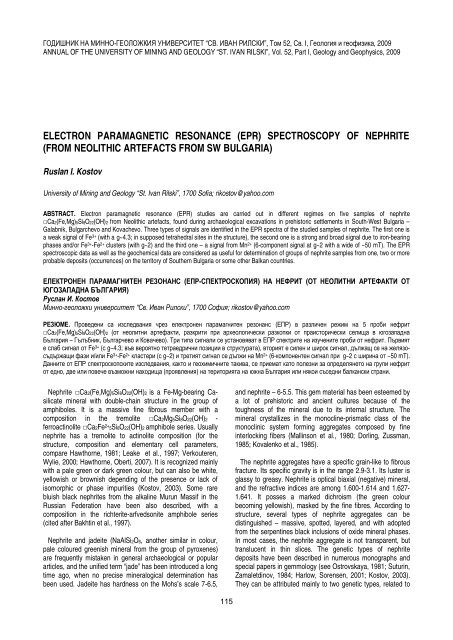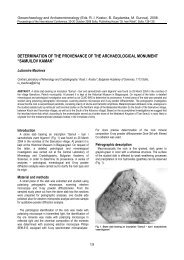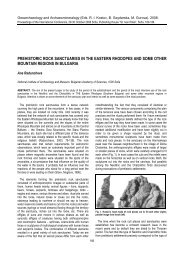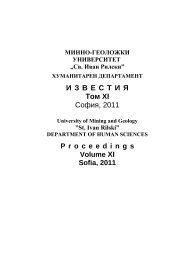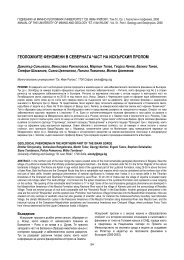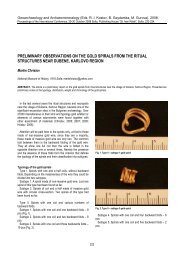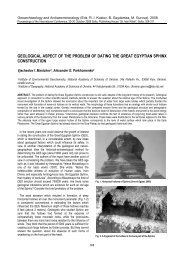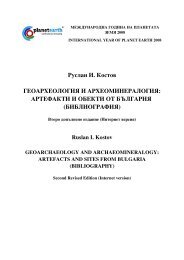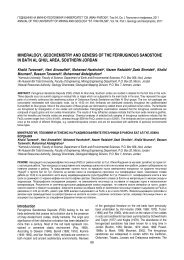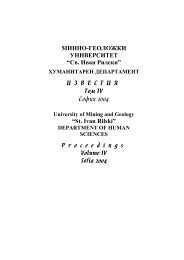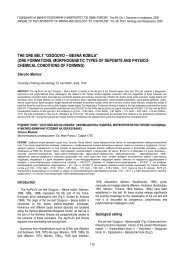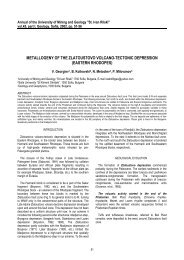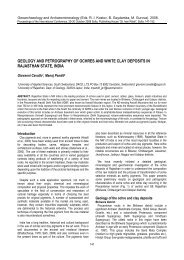electron paramagnetic resonance (epr) spectroscopy of nephrite
electron paramagnetic resonance (epr) spectroscopy of nephrite
electron paramagnetic resonance (epr) spectroscopy of nephrite
Create successful ePaper yourself
Turn your PDF publications into a flip-book with our unique Google optimized e-Paper software.
“. ”, 52, . I, , 2009<br />
ANNUAL OF THE UNIVERSITY OF MINING AND GEOLOGY “ST. IVAN RILSKI”, Vol. 52, Part I, Geology and Geophysics, 2009<br />
ELECTRON PARAMAGNETIC RESONANCE (EPR) SPECTROSCOPY OF NEPHRITE<br />
(FROM NEOLITHIC ARTEFACTS FROM SW BULGARIA)<br />
Ruslan I. Kostov<br />
University <strong>of</strong> Mining and Geology “St. Ivan Rilski”, 1700 S<strong>of</strong>ia; rikostov@yahoo.com<br />
ABSTRACT. Electron <strong>paramagnetic</strong> <strong>resonance</strong> (EPR) studies are carried out in different regimes on five samples <strong>of</strong> <strong>nephrite</strong><br />
Ca2(Fe,Mg)5Si8O22(OH)2 from Neolithic artefacts, found during archaeological excavations in prehistoric settlements in South-West Bulgaria –<br />
Galabnik, Bulgarchevo and Kovachevo. Three types <strong>of</strong> signals are identified in the EPR spectra <strong>of</strong> the studied samples <strong>of</strong> <strong>nephrite</strong>. The first one is<br />
a weak signal <strong>of</strong> Fe 3+ (with a g~4.3; in supposed tetrahedral sites in the structure), the second one is a strong and broad signal due to iron-bearing<br />
phases and/or Fe 3+ -Fe 2+ clusters (with g~2) and the third one – a signal from Mn 2+ (6-component signal at g~2 with a wide <strong>of</strong> ~50 mT). The EPR<br />
spectroscopic data as well as the geochemical data are considered as useful for determination <strong>of</strong> groups <strong>of</strong> <strong>nephrite</strong> samples from one, two or more<br />
probable deposits (occurrences) on the territory <strong>of</strong> Southern Bulgaria or some other Balkan countries.<br />
() ( <br />
)<br />
. <br />
“. ”, 1700 C; rikostov@yahoo.com<br />
. () 5 <br />
Ca2(Fe,Mg)5Si8O22(OH)2 ( , <br />
– , ). . <br />
Fe 3+ ( g~4.3; ), , -<br />
Fe 3+ -Fe 2+ ( g~2) Mn 2+ (6- g~2 ~50 mT).<br />
, , <br />
, () .<br />
Nephrite Ca2(Fe,Mg)5Si8O22(OH)2 is a Fe-Mg-bearing Casilicate<br />
mineral with double-chain structure in the group <strong>of</strong><br />
amphiboles. It is a massive fine fibrous member with a<br />
composition in the tremolite Ca2Mg5Si8O22(OH)2 -<br />
ferroactinolite Ca2Fe 2+ 5Si8O22(OH)2 amphibole series. Usually<br />
<strong>nephrite</strong> has a tremolite to actinolite composition (for the<br />
structure, composition and elementary cell parameters,<br />
compare Hawthorne, 1981; Leake et al., 1997; Verkouteren,<br />
Wylie, 2000; Hawthorne, Oberti, 2007). It is recognized mainly<br />
with a pale green or dark green colour, but can also be white,<br />
yellowish or brownish depending <strong>of</strong> the presence or lack <strong>of</strong><br />
isomorphic or phase impurities (Kostov, 2003). Some rare<br />
bluish black <strong>nephrite</strong>s from the alkaline Murun Massif in the<br />
Russian Federation have been also described, with a<br />
composition in the richterite-arfvedsonite amphibole series<br />
(cited after Bakhtin et al., 1997).<br />
Nephrite and jadeite (NaAlSi2O6, another similar in colour,<br />
pale coloured greenish mineral from the group <strong>of</strong> pyroxenes)<br />
are frequently mistaken in general archaeological or popular<br />
articles, and the unified term “jade” has been introduced a long<br />
time ago, when no precise mineralogical determination has<br />
been used. Jadeite has hardness on the Mohs’s scale 7-6.5,<br />
115<br />
and <strong>nephrite</strong> – 6-5.5. This gem material has been esteemed by<br />
a lot <strong>of</strong> prehistoric and ancient cultures because <strong>of</strong> the<br />
toughness <strong>of</strong> the mineral due to its internal structure. The<br />
mineral crystallizes in the monocline-prismatic class <strong>of</strong> the<br />
monoclinic system forming aggregates composed by fine<br />
interlocking fibers (Mallinson t al., 1980; Dorling, Zussman,<br />
1985; Kovalenko et al., 1985).<br />
The <strong>nephrite</strong> aggregates have a specific grain-like to fibrous<br />
fracture. Its specific gravity is in the range 2.9-3.1. Its luster is<br />
glassy to greasy. Nephrite is optical biaxial (negative) mineral,<br />
and the refractive indices are among 1.600-1.614 and 1.627-<br />
1.641. It posses a marked dichroism (the green colour<br />
becoming yellowish), masked by the fine fibres. According to<br />
structure, several types <strong>of</strong> <strong>nephrite</strong> aggregates can be<br />
distinguished – massive, spotted, layered, and with adopted<br />
from the serpentines black inclusions <strong>of</strong> oxide mineral phases.<br />
In most cases, the <strong>nephrite</strong> aggregate is not transparent, but<br />
translucent in thin slices. The genetic types <strong>of</strong> <strong>nephrite</strong><br />
deposits have been described in numerous monographs and<br />
special papers in gemmology (see Ostrovskaya, 1981; Suturin,<br />
Zamaletdinov, 1984; Harlow, Sorensen, 2001; Kostov, 2003).<br />
They can be attributed mainly to two genetic types, related to
serpentinites and to carbonate rocks. In the first case <strong>nephrite</strong><br />
associates with quartz-zoisite-albite and/or diopside-tremolite<br />
mineralization, and in the second case – with contact<br />
metasomatic zones in carbonate rocks (marbles).<br />
Nephrite artefacts are known from prehistoric sites in<br />
Bulgaria since the Early Neolithic and they disappear at the<br />
end <strong>of</strong> the Chalcolithic period (Kostov et al., 2003; Kostov,<br />
Bakamska, 2004; Kostov, Genadieva, 2004; Kostov, 2005;<br />
2005b; 2007a; 2007b; Kostov, Lang, 2005; Kostov, Machev,<br />
2007). The <strong>nephrite</strong> source is under discussion as no <strong>nephrite</strong><br />
deposits (occurrences) have been reported on the Balkans.<br />
The wide distribution <strong>of</strong> this gemmological material and its use<br />
for prestigious and attractive artefacts (Nikolov, 2005) during<br />
the mentioned prehistoric periods gives the opportunity for<br />
searching <strong>of</strong> local sources on the territory <strong>of</strong> southern Bulgaria<br />
and neighbouring countries on the Balkans where there is a<br />
suitable for <strong>nephrite</strong> formation geological setting with a lot <strong>of</strong><br />
serpentinied ultrabasic rocks outcrops. Because <strong>of</strong> their<br />
abundance, fine design and most early appearance in Europe<br />
and worldwide, the <strong>nephrite</strong> artefacts are related to a newly<br />
introduced prehistoric Balkan “<strong>nephrite</strong> culture” in analogy to<br />
the later in age Chinese “<strong>nephrite</strong> cultures” (Kostov, 2005b).<br />
The chemical compositions <strong>of</strong> the <strong>nephrite</strong> artefacts from<br />
some <strong>of</strong> the Neolithic sites in Bulgaria are close (Kostov,<br />
2007a; 2007b; N15-17). The high FeO content in some<br />
analyses will transfer the <strong>nephrite</strong> from the field <strong>of</strong> tremolite in<br />
the field <strong>of</strong> actinolite (Leake et al., 1997; for chemical analyses<br />
see Letnikov, Sekerin, 1983; Hung et al., 2006). For a more<br />
precise structural and chemical identification <strong>of</strong> some structural<br />
defects in <strong>nephrite</strong>, five samples are studied by <strong>electron</strong><br />
<strong>paramagnetic</strong> <strong>resonance</strong> (EPR; or <strong>electron</strong> spin <strong>resonance</strong> in<br />
some publications, ESR) <strong>spectroscopy</strong>.<br />
EPR spectra are recorded on a JEOL FA100 facility in the band<br />
(9.5 GHz; with standard conditions <strong>of</strong> the EPR spectra at<br />
a microwave power <strong>of</strong> 0.998 mW, modulation 100 kHz, time<br />
constant 4 and 8 minutes for different range <strong>of</strong> the<br />
corresponding magnetic field) at room temperature. The EPR<br />
spectra are recorded at different position <strong>of</strong> the magnetic field<br />
– 500 m for eventual detection <strong>of</strong> broad signals and<br />
identification <strong>of</strong> the Fe 3+ signal at g=4.3 and 100 mT for<br />
identification <strong>of</strong> <strong>electron</strong>-hole centers and trace elements in the<br />
g=2 region, where appears the 6-component signal <strong>of</strong> Mn 2+.<br />
For the EPR studies 5 samples <strong>of</strong> <strong>nephrite</strong> from artefacts<br />
were chosen, all <strong>of</strong> them found in prehistoric sites along the<br />
Struma River valley in South-West Bulgaria (previously<br />
analyzed by <strong>electron</strong> microprobe analyses; Kostov, 2007a;<br />
2007b): one sample from Bulgarchevo (fragment <strong>of</strong> an axe<br />
from the south pit; B1, pale green, N870), two samples from<br />
Galabnik (fragments <strong>of</strong> small axes; G1 – pale green, N92/330;<br />
G2 – dark green, without number) and two samples from<br />
Kovachevo (fragments <strong>of</strong> small axe or wedge; K1 – pale green,<br />
N54499/2001; K2 – dark green, N46203/1999). The artefacts<br />
from Galabnik and Kovachevo are from the Early Neolithic and<br />
the sample from Bulgarchevo – probably from the Late<br />
Neolithic. For the EPR <strong>spectroscopy</strong> study a volume <strong>of</strong> 5-7<br />
mm 2 material has been placed in a small quartz tube.<br />
According to previous EPR studies in tremolite are identified<br />
<strong>paramagnetic</strong> centers Mn 2+ (Bershov et al., 1966; Marfunin et<br />
116<br />
al., 1966; Manoogian, 1968; Golding t al., 1972; McGavin et<br />
al., 1982; Craighead Tennant t al., 2007; according to optical<br />
<strong>spectroscopy</strong> data – Bakhtin et al., 1979; Bakhtin, 1985), Fe 3+<br />
(McGavin et al., 1984; Craighead Tennant t al., 2007) and<br />
phosphorus-bearing groups (Bershov, 1970), and in actinolite –<br />
Mn 2+ and Fe 3+ (Gopal t al., 2004) (for reviews with data on<br />
tremolite-actinolite see Calas, 1988; Vassilikou-Dova, 1993). In<br />
the EPR spectra <strong>of</strong> amphibole also have been registered<br />
several other centers with a g-factor value about 2, all <strong>of</strong> them<br />
with a suggested hole nature (Matyash et al., 1980).<br />
Three types <strong>of</strong> signals are identified in the EPR spectra <strong>of</strong><br />
the studied samples <strong>of</strong> <strong>nephrite</strong> from Neolithic artefacts (Fig.<br />
1). The first one is a weak signal <strong>of</strong> Fe3+ (with g~4.3; in<br />
tetrahedral sites in the structure), the second one – a strong<br />
and broad signal due to iron-bearing phases and/or Fe<br />
3+-Fe 2+<br />
clusters (with g~2 with a superimposed signal) and the third<br />
one – signal from Mn 2+ (6-component signal at g~2 with a wide<br />
<strong>of</strong> ~50 mT). In sample G1 a very strong broad signal is<br />
detected (~100 mT; shifted to g~3) which is attributed most<br />
probably to numerous iron-bearing phase (this signal does not<br />
allow to identify other weaker signals from other <strong>paramagnetic</strong><br />
centers).<br />
Similar impurity centers are known in several minerals, as<br />
well as in natural glasses, including in perlites from Bulgarian<br />
deposits (Kostov, Yanev, 1996). It is assumed, that the width <strong>of</strong><br />
the signal at g~2 in the case with the iron clusters corresponds<br />
to their size (Calas, Petiau, 1983). A weak EPR signal from<br />
Fe 3+ is detected in both samples from the Kovachevo site.<br />
Such signal has been registered without comment (Manoogian,<br />
1968), but later it has been attributed to high-spin Fe 3+ in<br />
unclear structural sites (McGavin et al., 1982). A signal from<br />
iron-bearing microphases or Fe 3+-Fe 2+ clusters is recorded in<br />
the spectra <strong>of</strong> all the samples with maximum intensity in the<br />
pale coloured sample from Kovachevo (1).<br />
The ion Mn 2+ substitutes in the amphibole structure (with a<br />
tremolite to actinolite composition) both Ca 2+ and Mg 2+, with a<br />
specific EPR spectrum ( 55Mn; spin 5/2; abundance 100%). The<br />
investigations in an another band (Q; 94.1 GHz) display, that<br />
the well exposed six-component structure in the spectra is due<br />
to replacement in the structural position <strong>of</strong> Ca 2+ by n 2+<br />
(McGavin et al., 1982; Craighead Tennant t al., 2007), and<br />
that is dominantly the position <strong>of</strong> the 4 deformed polyhedron<br />
(Papike et al., 1969). In the studied samples Mn 2+ has been<br />
registered in all the EPR spectra, even in those samples,<br />
where the element has not been detected by <strong>electron</strong><br />
microprobe analysis. The arbitrary intensity <strong>of</strong> the EPR peaks<br />
corresponds to the manganese content – thus the EPR studies<br />
can be used for a quantative or semiquantative evaluation <strong>of</strong><br />
the manganese impurity. It is in lower concentrations in the<br />
darker <strong>nephrite</strong> varieties (samples G2 and 2).<br />
EPR data, especially for <strong>nephrite</strong>, are known published only<br />
for samples from New Zealand (Craighead Tennant t al.,<br />
2007) or for some sort <strong>of</strong> fibrous actinolite (Gopal et al., 2004).<br />
In both cases the EPR data are being correlated with data from<br />
other spectroscopic methods (the EPR spectra are similar to<br />
those, which are obtained from the Bulgarian samples).
G2<br />
B1<br />
0 100 200 300 400 500<br />
G1<br />
Magnetic field, mT<br />
0 100 200 300 400 500<br />
Magnetic field, mT<br />
0 100 200 300 400 500<br />
K1<br />
Magnetic field, mT<br />
0 100 200 300 400 500<br />
Magnetic field, mT<br />
117<br />
B1<br />
280 300 320 340 360 380<br />
G1<br />
Magnetic field, mT<br />
280 300 320 340 360 380<br />
G2<br />
Magnetic field, mT<br />
280 300 320 340 360 380<br />
K1<br />
Magnetic field, mT<br />
280 300 320 340 360 380<br />
Magnetic field, mT
K2<br />
0 100 200 300 400 500<br />
Magnetic field, mT<br />
118<br />
K2<br />
280 300 320 340 360 380<br />
Magnetic field, mT<br />
Fig. 1. ERP spectra <strong>of</strong> <strong>nephrite</strong> from Neolithic artefacts (left – width <strong>of</strong> the magnetic field 500 m; right – width <strong>of</strong> the magnetic field 100<br />
, the arrows show the range <strong>of</strong> the 6-component signal <strong>of</strong> Mn 2+ ): B1 – Bulgarchevo; G1 and G2 – Galabnik; 1 and 2 – Kovachevo<br />
(the same number <strong>of</strong> sample can be compared from their chemical analyses, Kostov, 2007b).<br />
Attention has to be paid, during the EPR analyses <strong>of</strong> <strong>nephrite</strong><br />
that the sample are not been contaminated with serpentine<br />
minerals (serpentinite artefacts usually are close to <strong>nephrite</strong><br />
artefacts in archaeological sites; Kostov, 2008), as according<br />
to EPR studies in antigorite one can be find the same<br />
impurities elements as Fe 3+ (with g ~4.3) and Mn 2+ (six<br />
lines at g~2; width 92.5 G) (Reddy t al., 2001).<br />
According to Mössbauer <strong>spectroscopy</strong> data <strong>of</strong> pale green<br />
and dark green <strong>nephrite</strong>s, it has been found that the spectra for<br />
tremolite and actinolite are practically identical, in both cases<br />
with two quadruple doublets from ions Fe 2+ in two nonequivalent<br />
octahedral positions – the inner doublet <strong>of</strong> Fe 2+ in<br />
M2 sites, and the outer doublet correspondingly to Fe 2+ in the<br />
M1 and 3 sites (Platonov et al., 1975; Suturin, Zamaletdinov,<br />
1984). According to some other data (Wilkins, 2003; Craighead<br />
Tennant t al., 2007) the inner doublet corresponds to Fe 2+ in<br />
the 4 sites.<br />
The position <strong>of</strong> the iron ions is registered by Mössbauer<br />
<strong>spectroscopy</strong> (Burns, Greaves, 1971; Craighead Tennant t<br />
al., 2007; general data for the amphiboles compare in Matyash<br />
et al., 1980) and that <strong>of</strong> the Mn 2+ (bands at 570 nm in the<br />
position <strong>of</strong> Ca 2+ and at 620 nm in the position <strong>of</strong> Mg 2+), Cr 3+<br />
(690-700 nm) and Fe 3+ (720-730 nm), rarely the center -<br />
(450-500 nm) by X-ray luminescence data (together with<br />
thermoluminescence) <strong>of</strong> <strong>nephrite</strong>s (Boroznovskaya et al.,<br />
2007). It has been stressed, that among the green <strong>nephrite</strong>s <strong>of</strong><br />
a serpentinite origin the X-ray luminescence decreases in the<br />
presence <strong>of</strong> Fe 2+, and among the pale coloured <strong>nephrite</strong>s from<br />
the carbonate rocks an intensive X-ray luminescence <strong>of</strong> Mn 2+<br />
and Cr 3+ both is detected.<br />
During the study <strong>of</strong> the optical spectra <strong>of</strong> <strong>nephrite</strong>s from<br />
different deposits in general are obtained bands in the regions<br />
21000-24000 cm -1 (from Fe 2+ in octahedral sites), 14000-<br />
16000 cm -1 (with a significant importance for the intensity <strong>of</strong> the<br />
green colouration) or bands <strong>of</strong> charge transfer from transitions<br />
between iron ions <strong>of</strong> different charge in different octahedral<br />
sites Fe 2+ (M1) Fe 3+ (M2) (in charge for the bluish tint in<br />
some <strong>nephrite</strong>s) and 10000-11000 cm -1 (from Fe 2+ in<br />
octahedral sites in geometrically non-equivalent sites in the<br />
structure) (Platonov et al., 1975). The three-charge iron can be<br />
detected in the optical spectra by the charge transfer bands 2-<br />
Fe 3+ with an increasing yellowish hue (for content over 1%<br />
Fe2O3), and the other important colouring agent – the ion Cr 3+<br />
has absorption bands with a complex nature about 14000-<br />
16000 and 22000-23000 cm -1 (Platonov et al., 1975). The<br />
colour <strong>of</strong> the studied <strong>nephrite</strong>s from Russia and Kazakhstan<br />
varies in the region 507-576 nm, and the brightness – from<br />
1.992 (dark gray) to 11.642% (white to a pale green colour),<br />
dominating being the samples in the range <strong>of</strong> the colour hue<br />
545-565 nm and brightness 2.5-4% (Suturin et al., 1980;<br />
Suturin, Zamaletdinov, 1984). The mentioned data for <strong>nephrite</strong><br />
correspond to amphiboles <strong>of</strong> a tremolite to actinolite<br />
composition (Bakhtin, 1985). The absorption band at 415 nm,<br />
which has been identified among the rare dark bluish<br />
<strong>nephrite</strong>s, corresponds to an <strong>electron</strong> transfer <strong>of</strong> Mn 2+ in an<br />
octahedral site (in the amphibole structure this is mostly the M4<br />
site) (Bakhtin et al., 1997). The absorption bands at 520, 560<br />
and 800 nm in a manganese-bearing tremolite (hexagonite)<br />
are related to ions Mn 3+ in an octahedral 1, 2 and 3 site<br />
(Bakhtin, 1985).<br />
The data from the microprobe analysis <strong>of</strong> the <strong>nephrite</strong><br />
samples and <strong>of</strong> the oxide inclusions in them, as well as the<br />
content <strong>of</strong> the trace elements according to spectroscopic data<br />
point out that at least two different mineral deposits<br />
(occurrences) can be suggested for their origin. The samples<br />
from the Kovachevo site can be placed in one group and the<br />
samples from the Galabnik and Bulgarchevo sites – in a<br />
second one. Visually spotted <strong>nephrite</strong> prehistoric implements<br />
from other sites in Bulgaria (for example from the Neolithic site<br />
Kurdjali or the Chalcolithic site at Varna II) have not been<br />
studied, and in this respect at least one additional unknown<br />
type <strong>of</strong> <strong>nephrite</strong> deposit (occurrence) has to be suggested for<br />
search on the territory <strong>of</strong> Bulgaria or on the territory <strong>of</strong> the near<br />
to the border southern Balkan countries.<br />
Acknowledgements. The author is grateful to Pr<strong>of</strong>. Dr. Sc.<br />
Nikola Yordanov (Institute <strong>of</strong> Catalyses, Bulgarian Academy <strong>of</strong><br />
Sciences) for giving access to the EPR equipment, as well as<br />
to A. Bakamska (Historical Museum, Pernik), Dr. M. Grebska-<br />
Kulova and I. Kulov (Regional Historical Museum,<br />
Blagoevgrad) and E. Anastasova (National Archaeological<br />
Institute and Museum, Bulgarian Academy <strong>of</strong> Sciences) for the<br />
samples <strong>of</strong> <strong>nephrite</strong> artefacts.
References<br />
Bakhtin, . I. 1976. Optical spectra <strong>of</strong> tremolite and actinolite. –<br />
Crystallography, 21, 5, 1036-1038 (in Russian).<br />
Bakhtin, . I. 1985. Rock-Forming Silicates: Optical Spectra,<br />
Crystal Chemistry, Colouration Tendencies and<br />
Typomorphism. Kazan University, Kazan, 192 p. (in<br />
Russian)<br />
Bakhtin, . I., . . Min’ko, V. . Vinokurov. 1979. Optical<br />
spectra <strong>of</strong> ions Mn 2+ in amphiboles. – In: Spectroscopy <strong>of</strong><br />
Minerals and Rocks. Kazan University, Kazan, 3-7 (in<br />
Russian).<br />
Bakhtin, . I., . N. Lopatin, . . Konev. 1997. Nature <strong>of</strong><br />
colour <strong>of</strong> Siberian <strong>nephrite</strong>s. – Izvestiya VUZ, Geologiya i<br />
Razvedka, 6, 145-147 (in Russian).<br />
Bershov, L. V. 1970. EPR spectra and <strong>electron</strong>ic composition<br />
<strong>of</strong> some phosphorus-bearing radicals. – Theoretical and<br />
Experimental Chemistry, 6, 3, 397-402 (in Russian).<br />
Bershov, L. V., A. S. Marfunin, R. I. Mineeva. 1966. Electron<br />
<strong>paramagnetic</strong> <strong>resonance</strong> <strong>of</strong> Mn 2+ in tremolite. –<br />
Geochemistry, 4, 464-466 (in Russian).<br />
Boroznovskaya, N. N., L. A. Zypryanova, I. N. Golubitskaya, V.<br />
M. Klimkin. 2007. Luminescence and colour <strong>of</strong> <strong>nephrite</strong> as<br />
reflection <strong>of</strong> its internal composition. – In: Crystal<br />
Chemistry and Crystal Morphology <strong>of</strong> Minerals. Sankt<br />
Petersburg, 232-234.<br />
Burns, R. G., C. J. Greaves. 1971. Correlation <strong>of</strong> infrared and<br />
Mössbauer site population measurements <strong>of</strong> actinolites. –<br />
Amer. Mineral., 56, 2010-2033.<br />
Calas, G. 1988. Electron <strong>paramagnetic</strong> <strong>resonance</strong>. – In:<br />
Spectroscopic Methods in Mineralogy and Geology.<br />
Reviews in Mineralogy, 18, 513-571.<br />
Calas, G., J. Petiau. 1983. Structure <strong>of</strong> oxide glasses:<br />
spectroscopic studies <strong>of</strong> local order and crystallochemistry.<br />
Geochemical implications. – Bull. Minéral., 106, 1-2, 33-55.<br />
Craighead Tennant, W., R. F. C. Claridge, C. A. McCammon,<br />
A. I. Smirnov, R. J. Beck. 2005. Structural studies <strong>of</strong> New<br />
Zealand pounamu using Mössbauer <strong>spectroscopy</strong> and<br />
<strong>electron</strong> <strong>paramagnetic</strong> <strong>resonance</strong>. – J. Royal Society <strong>of</strong><br />
New Zealand, 35, 4, 385-398.<br />
Dorling, M., J. Zussman. 1985. An investigation <strong>of</strong> <strong>nephrite</strong><br />
jade by <strong>electron</strong> microscopy. – Miner. Mag., 49, 1, 31-36.<br />
Golding, R. M., R. H. Newman, A. D. Rae, W. C. Tennant.<br />
1972. Single crystal ESR study <strong>of</strong> Mn 2+ in natural tremolite.<br />
– J. Chem. Phys., 57, 5, 1912-1918.<br />
Gopal, N. O., K. V. Narasimhulu, J. L. Rao. 2004. EPR, optical,<br />
infrared and Raman spectral studies <strong>of</strong> ctinolite mineral. –<br />
Spectrochimica Acta Part A: Molecular and Biomolecular<br />
Spectroscopy, 60, 11, 2441-2448.<br />
Harlow, G. E., S. S. Sorensen. 2001. Jade: occurrence and<br />
metasomatic origin. – The Australian Gemmologist, 21, 7-<br />
10.<br />
Hawthorne, F. C. 1981. Crystal chemistry <strong>of</strong> the amphiboles. –<br />
In: Amphiboles and Other Hydrous Pyriboles – Mineralogy<br />
(Ed. by D. R. Veblen). Reviews in Mineralogy, 9A, 1-102.<br />
Hawthorne, F. C., R. Oberti. 2007. Amphiboles: crystal<br />
chemistry. – In: Amphiboles. Reviews in Mineralogy, 67, 1-<br />
54.<br />
Hung, H.-C., Y. Iizuka, P. Bellwood. 2006. Taiwan jade in the<br />
context <strong>of</strong> Southeast Asian archaeology. – In: E. A. Bacus,<br />
I. C. Glover and V. C. Pigot (Eds.) Uncovering Southeast<br />
Asia’s Past. The British Museum, London, National<br />
University Press, Singapore, 203-215.<br />
119<br />
Kostov, R. I. 2003. Precious Minerals: Testing, Distribution,<br />
Cutting, History and Application (Gemmology). Pens<strong>of</strong>t,<br />
S<strong>of</strong>ia-Moscow, X, 453 p. (in Bulgarian)<br />
Kostov, R. I. 2005a. Gemmological characteristics <strong>of</strong> the<br />
<strong>nephrite</strong> prehistoric (Neolithic and Chalcolithic) artefacts<br />
from the territory <strong>of</strong> Bulgaria. – Ann. S<strong>of</strong>ia University,<br />
Faculty <strong>of</strong> Geology and Geography, 97, Part 1, Geology,<br />
55-75 (in Bulgarian with an English abstract).<br />
Kostov, R. I. 2005b. Gemmological significance <strong>of</strong> the<br />
prehistoric Balkan “<strong>nephrite</strong> culture” (cases from Bulgaria).<br />
– Ann. University <strong>of</strong> Mining and Geology, 48, Part I,<br />
Geology and Geophysics, 91-94.<br />
Kostov, R. I. 2007a. Archaeomineralogy <strong>of</strong> Neolithic and<br />
Chalcolithic Artefacts from Bulgaria and their Significance<br />
to Gemmology. Publishing House “St. Ivan Rilski”, S<strong>of</strong>ia,<br />
126 p., I-VIII (in Bulgarian with an English summary).<br />
Kostov, R. I. 2007b. Chemical composition <strong>of</strong> <strong>nephrite</strong> Neolithic<br />
artefacts from Bulgaria in comparison to analyses from<br />
world deposits. – Ann. University <strong>of</strong> Mining and Geology,<br />
50, Part I, Geology and Geophysics, 55-60 (in Bulgarian<br />
with an English summary).<br />
Kostov, R. I. 2008. Mineralogical peculiarities <strong>of</strong> antigorite<br />
serpentinit as a raw material among the Neolithic and<br />
Chalcolithic artefacts on the territory <strong>of</strong> Bulgaria. – In: The<br />
Varna Chalcolithic Necropolis and Problems <strong>of</strong> the<br />
Prehistory <strong>of</strong> South-East Europe (Ed. by V. Slavchev). Acta<br />
Musei Varnaensis, 6, 61-70 (in Bulgarian with an English<br />
summary).<br />
Kostov, R. I., A. Bakamska. 2004. Nephrite artefacts from the<br />
Early Neolithic settlement Galabnic, district <strong>of</strong> Pernik. –<br />
Geology and Mineral Resources, 4, 38-43 (in Bulgarian<br />
with an English summary).<br />
Kostov, R. I., V. Genadieva. 2004. Nephrite-jade prehistoric<br />
artefacts from the region <strong>of</strong> Kyustendil. – Mining and<br />
Geology, 10, 35-37 (in Bulgarian with an English<br />
summary).<br />
Kostov, R. I., F. Lang. 2005. Nephrite artefacts from the<br />
Karanovo prehistoric site, Bulgaria. – Geology and Mineral<br />
Resources, 12, 9, 35-39.<br />
Kostov, R. I., Ph. Machev. 2008. Mineralogical and<br />
petrographic characteristics <strong>of</strong> <strong>nephrite</strong> and other stone<br />
artefacts from the Neolithic site Kovachevo in Southwest<br />
Bulgaria. – In: National Conference “Prehistoric Studies in<br />
Bulgaria: New Challenges” (Ed. by M. Gyurova). Peshtera,<br />
26-29 April 2006, Bulgarian Academy <strong>of</strong> Sciences, S<strong>of</strong>ia,<br />
70-78 (in Bulgarian with an English summary).<br />
Kostov, R. I., Y. Yanev. 1996. EPR data on volcanic siliceous<br />
glasses from the Eastern Rhodopes (Bulgaria) and the<br />
Lipari Island (Italy). – Appl. Magn. Resonance, 10, 431-<br />
438.<br />
Kostov, R. I., V. Pelevina, V. S. Slavchev. 2003. Mineralogical<br />
and gemmological characteristics <strong>of</strong> the non-metallic<br />
jewellery objects from the Middle Chalcolithic necropolis<br />
Varna II. – Geology and Mineral Resources, 9, 23-26 (in<br />
Bulgarian with an English summary).<br />
Kovalenko, I. V., I. P. Khadji, V. S. Kovalenko, . F. Svidirenko.<br />
1985. Peculiarities <strong>of</strong> the microstructure and composition <strong>of</strong><br />
<strong>nephrite</strong>s <strong>of</strong> ultramafic origin. – Zap. Vses. Mineral. Obsht.,<br />
114, 6, 707-712 (in Russian).<br />
Leake, B. E., A. R. Woolley, C. E. S. Arps, W. D. Birch, M. C.<br />
Gilbert, J. D. Grice, F. C. Hawthorne, A. Kato, H. J. Kisch,<br />
V. G. Krivovichev, K. Linthout, J. Laird, J. A. Mandarino, W.<br />
V. Maresch, E. H. Nickel, N. M. S. Rock, J. C.
Schumacher, D. C. Smith, N. C. N. Stephenson, L.<br />
Ungaretti, E. J. W. Whittaker, G. Youzhi. 1997.<br />
Nomenclature <strong>of</strong> amphiboles: report <strong>of</strong> the Subcommittee<br />
on Amphiboles <strong>of</strong> the International Mineralogical<br />
Association, Commission on New Minerals and Mineral<br />
Names. – The Canadian Mineralogist, 35, 219-246.<br />
Letnikov, F. ., . N. Sekerin. 1983. Peculiarities <strong>of</strong> the<br />
composition and genesis <strong>of</strong> <strong>nephrite</strong>s from the Sayan-<br />
Baikal mountain region. – In: Mineralogy and Genesis <strong>of</strong><br />
Coloured Stones in Eastern Siberia. Nauka, Nobosibirsk,<br />
96-103 (in Russian).<br />
Mallinson, L. G., D. A. Jefferson, J. M. Thomas, J. L.<br />
Hutchinson. 1980. The internal structure <strong>of</strong> <strong>nephrite</strong>. –<br />
Royal Soc. London Phil. Trans. A, 295, 537-551.<br />
Manoogian, A. 1968. Intensity <strong>of</strong> allowed and forbidden<br />
<strong>electron</strong> spin <strong>resonance</strong> lines <strong>of</strong> Mn 2+ in tremolite. – Can. J.<br />
Physics, 48, 1029-1033.<br />
Marfunin, A. S., L. V. Bershov, R. M. Mineeva. 1966. La<br />
résonance paramagnétique électronique de l’ion VO 2+ das<br />
le sphène et l’apophyllite et de l’ion Mn 2+ dans la trémolite,<br />
l’apophyllite et la scheelite. – Bull Soc. Franç. Minér.<br />
Cristall., 89, 177-189.<br />
Matyash, I. V., . . alichenko, . S. Litovchenko, V. P.<br />
Ivanitskiy, E. V. Pol’shin, . I. Mel’nikov. 1980.<br />
Radio<strong>spectroscopy</strong> <strong>of</strong> Micas and Amphiboles. Naukova<br />
Dumka, Kiev, 188 p. (in Russian)<br />
McGavin, D. G., R. A. Palmer, W. C. Tennant, S. D. Devine.<br />
1982. Use <strong>of</strong> ultrasonically modulated <strong>electron</strong> <strong>resonance</strong><br />
to study s-state ions in mineral crystals: Mn 2+, Fe 3+ in<br />
tremolite. – Physics and Chemistry <strong>of</strong> Minerals, 8, 5, 200-<br />
205.<br />
Nikolov, V. 2005. Prestige and signs <strong>of</strong> prestige in the Neolithic<br />
society. – Arheologiya (Archaeology), 1-4, 7-17 (in<br />
Bulgarian).<br />
Ostrovskaya, I. V. 1981. Tremolite. – In: Minerals. . III. Part 3.<br />
Nauka, Moscow, 82 (in Russian).<br />
120<br />
Papike, J. J., M. Ross, J. R. Clark. 1969. Crystal-chemical<br />
characteristics <strong>of</strong> clinoamphiboles based on five new<br />
structure refinements. – Miner. Soc. Amer., Special Paper,<br />
2, 117-136.<br />
Platonov, A. N., V. N. Belichenko, L. V. Nikol’skaya, E. V.<br />
Pol’shin. 1975. About the colour <strong>of</strong> <strong>nephrite</strong>s. –<br />
Konstitutsiya i Svoistv Mineralov, 9, 52-58 (in Russian).<br />
Poole, Ch. P., Jr., J. R. H. Farach, T. P. Bishop. 1978. Electron<br />
spin <strong>resonance</strong> <strong>of</strong> minerals. Part II. Silicates. – Magn. Res.<br />
Rev., 4, 4, 225-289.<br />
Reddy, S. N., R. V. S. S. N. Ravikumar, B. J. Reddy, Y. P.<br />
Reddy, P. S. Rao. 2001. Spectroscopic investigations on<br />
Fe 3+, Fe 2+ and Mn 2+ bearing antigorite mineral. – N. Jb.<br />
Mineral. Mh., 6, 261-270.<br />
Suturin, N. A., P. S. Zamaletdinov. 1984. Nephrites. Nauka,<br />
Novosibirsk, 150 p. (in Russian)<br />
Suturin, N. A., P. S. Zamaletdinov, F. . Letnikov, . P.<br />
Sekerin, G. V. Burmakina, . . Suturina, . N. Platonov,<br />
V. N. Belichenko, . Ya. Vohmentsev. 1980. Mineralogy<br />
and genesis <strong>of</strong> <strong>nephrite</strong>s in the USSR. – In: Samotsveti<br />
(Gemstones). Nauka, Leningrad, 87-97 (in Russian).<br />
Vassilikou-Dova, A. B. 1993. EPR-determined site distribution<br />
<strong>of</strong> low concentrations <strong>of</strong> transition metal ions in minerals:<br />
review and predictions. – Amer. Mineral., 78, 1-2, 49-55.<br />
Verkouteren, J. R., A. G. Wylie. 2000. The tremolite-actinoliteferro-actinolite<br />
series: systematic relationships among cell<br />
parameters, composition, optical properties, and habit, and<br />
evidence <strong>of</strong> discontinuities. – Amer. Mineral., 85, 1239-<br />
1354.<br />
Wilkins, C. J., W. Craighead Tennant, B. E. Willianson, C. A.<br />
McCammon. 2003. Spectroscopic and related evidence on<br />
the coloring and constitution <strong>of</strong> New Zealand jade. – Amer.<br />
Mineral., 88, 8-9, 1336-1344.<br />
Recommended for publication by<br />
Chair <strong>of</strong> “Mineralogy and Petrography”, FGP


